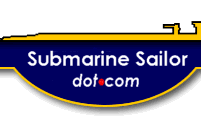 |
 |
THE DBF PIN
by Patrick Meagher TMC(SS) USN RET.
Probably none of today’s submariners know the origin or the
significance of the Diesel Boats Forever (DBF) pin. Most former Diesel
boat sailors are also ignorant of its origins even though it is worn with
pride on many SubVets vests.
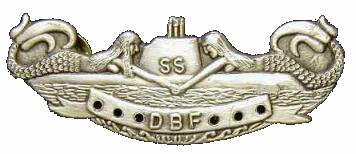 The last diesel attack boat built for the US Navy was commissioned in
October 1959 (1). At that time there were five classes of nuke boats along
with two “one off” designs in various stages of construction and pre
commissioning trials along with USS Nautilus SSN-571, and the four Skate
class boats in operational status (2). The diesel boat force made up
predominantly of modernized fleet boats (Fleet Snorkels, Guppy 1A’s, Guppy
2’s, Guppy 2A’s, Radar picket, Regulus missile, troop carrier, and
hunter-killer conversions), six Tang’s plus Darter, Growler, Greyback, the
two Salmon’s and the three “B” girls had become the source of
pre-commissioning crews for the nuke boats. There was a steady stream of
9901’s passing through the diesel boat force, spending seven months
onboard learning the boat and earning their dolphins before departing for
nuke school. A smaller number of career enlisted electricians, machinist
mates, enginemen, and electronic technicians also volunteered for the nuke
program. Admiral Hyman Rickover personally interviewed all officers
applying for the nuclear power program as well as many of the senior
enlisted submariners. Tales of Rickover’s interviews consistently reported
on his efforts to intimidate and discredit the accomplishments of the
officer interviewee’s, alienating many who interviewed with him.
Disturbing reports from senior enlisted veterans of the nuke boat navy in
favorite submarine “watering holes” ashore indicated Rickover’s new
operating philosophy was at work in the engineering spaces. “Don’t trust
enlisted engineers.” Nuke trained officers consistently checked, double
checked, and triple checked the work and system lineups of the enlisted
engineers, a major change to the long standing professional relationship
between enlisted and officer submariners. In addition, “front-enders” the
non-nukes, were reporting excessive wardroom focus on the engineering
plant at the expense of the historic mission of the submarine. They were
also describing the “no-touch” rule from the reactor compartment aft. If
you were not a nuke, you couldn’t touch any part of the engineering
plant-period. You could learn it in theory, identify major components,
valves and panels, but that was it. Gone was the traditional submarine
qualification program that demanded standing all watches under instruction
as well as rigging all compartments for all evolutions. Lost on most
submariners was the reason Rickover imposed the new operational Philosophy
which is best summarized by Gary E. Weir (3) The last diesel attack boat built for the US Navy was commissioned in
October 1959 (1). At that time there were five classes of nuke boats along
with two “one off” designs in various stages of construction and pre
commissioning trials along with USS Nautilus SSN-571, and the four Skate
class boats in operational status (2). The diesel boat force made up
predominantly of modernized fleet boats (Fleet Snorkels, Guppy 1A’s, Guppy
2’s, Guppy 2A’s, Radar picket, Regulus missile, troop carrier, and
hunter-killer conversions), six Tang’s plus Darter, Growler, Greyback, the
two Salmon’s and the three “B” girls had become the source of
pre-commissioning crews for the nuke boats. There was a steady stream of
9901’s passing through the diesel boat force, spending seven months
onboard learning the boat and earning their dolphins before departing for
nuke school. A smaller number of career enlisted electricians, machinist
mates, enginemen, and electronic technicians also volunteered for the nuke
program. Admiral Hyman Rickover personally interviewed all officers
applying for the nuclear power program as well as many of the senior
enlisted submariners. Tales of Rickover’s interviews consistently reported
on his efforts to intimidate and discredit the accomplishments of the
officer interviewee’s, alienating many who interviewed with him.
Disturbing reports from senior enlisted veterans of the nuke boat navy in
favorite submarine “watering holes” ashore indicated Rickover’s new
operating philosophy was at work in the engineering spaces. “Don’t trust
enlisted engineers.” Nuke trained officers consistently checked, double
checked, and triple checked the work and system lineups of the enlisted
engineers, a major change to the long standing professional relationship
between enlisted and officer submariners. In addition, “front-enders” the
non-nukes, were reporting excessive wardroom focus on the engineering
plant at the expense of the historic mission of the submarine. They were
also describing the “no-touch” rule from the reactor compartment aft. If
you were not a nuke, you couldn’t touch any part of the engineering
plant-period. You could learn it in theory, identify major components,
valves and panels, but that was it. Gone was the traditional submarine
qualification program that demanded standing all watches under instruction
as well as rigging all compartments for all evolutions. Lost on most
submariners was the reason Rickover imposed the new operational Philosophy
which is best summarized by Gary E. Weir (3)
“The potential for major disaster in the nuclear propulsion program
caused him (Rickover) to elevate professional competence, discipline,
and responsibility to the rank of absolute virtues required of every
naval and private participant…..Unfortunately for a great many people,
Rickover’s personal and professional manner made the lesson difficult to
learn.” (pg. 168)
By early 1967 total nuclear submarine crews numbered in excess of one
hundred counting blue and gold SSBN crews with sixty four nuke boats
(forty one of which were SSBN’s) in commission. The thirty seven Sturgeon
class nuke boats would start to commission with the lead ship in March of
that year. The Diesel boat fleet in contrast numbered slightly over one
hundred in commission with most of the modernized fleet type boats nearing
the end of their useful lives. Former SSR’s, SSK’s, and Fleet Snorkels
would start to decommission within eighteen months to be followed shortly
by the guppy conversions.
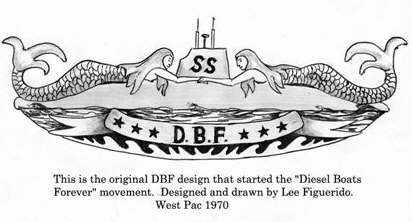 More and more Rickover trained officers were appearing on squadron and
force staffs bringing with them Rickover’s operational philosophy. It was
apparent to all that the diesel boat navy were dinosaurs soon to be
extinct along with their officer community who were either unwilling to
become nukes or passed over by Rickover as unfit to become nuke boat
engineers in order to ascend to command of a nuke boat (4). Diesel boats
were still conducting most of the non-deterrent submarine operations
including “special missions.” Nuke attack boats were “wowing” many with
their performance and potential along with occasional contributions such
as “a mission of great value to the government of the United States of
America.” The nukes were not without their teething problems however. It
was not uncommon for a nuke boat to be unable to get underway as scheduled
due to an “engineering problem.” A refueling every three to four years
also required a shipyard stay of from eighteen months to two years again
reducing the number of nuke boats available for operations. So it was left
to the diesel boats to pick up the slack. More and more Rickover trained officers were appearing on squadron and
force staffs bringing with them Rickover’s operational philosophy. It was
apparent to all that the diesel boat navy were dinosaurs soon to be
extinct along with their officer community who were either unwilling to
become nukes or passed over by Rickover as unfit to become nuke boat
engineers in order to ascend to command of a nuke boat (4). Diesel boats
were still conducting most of the non-deterrent submarine operations
including “special missions.” Nuke attack boats were “wowing” many with
their performance and potential along with occasional contributions such
as “a mission of great value to the government of the United States of
America.” The nukes were not without their teething problems however. It
was not uncommon for a nuke boat to be unable to get underway as scheduled
due to an “engineering problem.” A refueling every three to four years
also required a shipyard stay of from eighteen months to two years again
reducing the number of nuke boats available for operations. So it was left
to the diesel boats to pick up the slack.
‘Dex’ Armstrong (5) describes the thinking of the enlisted smokeboat
sailor during these years.
“We were it…One crew. Nobody took over our boats when we came in.
When the old girl went to sea, we were there. The same names, same
faces, same officers forward. If someone failed to maintain a system or
piece of equipment, the Chief of the Boat knew precisely what butt to
put his boot into when ass-kicking time rolled around. Those were great
days… Didn’t know it then, that came later…much later. We knew nuclear
boats represented progress but we didn’t think much about it……We could
see the future of submarining floating in the after nest. The big, fat,
black monsters getting all the attention. High speed, deep-diving
ugliness rapidly sending our smokeboat fleet up the river to the
scrapyard. To us nuke boats were like elephants… They were big as hell,
uglier than sin and none of us had any idea what went on inside of the
damn things. They were just there.” (pg.5)
This brings us to the DBF pin. In 1969 USS Barbel SS-580, the lead ship
of the last class of diesel boats built for the US Navy was deployed to
WesPac. While on a “special mission” in early 1970 the control room gang
got into one of those nuke boat vs. diesel boat discussions.
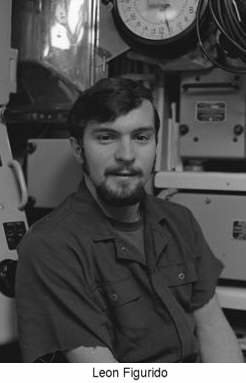 It was pointed out during the discussion that on a number of occasions
a diesel boat would have to get underway for a “broke-down” nuke boat
again proving the superiority of smokeboats over unreliable nuke boats.
Someone suggested there ought to be a pin for smokeboat sailors, something
like the new Polaris Deterrent Patrol Pin for “boomer” sailors, for the
times you had to take a nuke boat commitment because they were broke-
down. A contest was commissioned to design the pin. ETR3(SS) Leon
Figurido’s winning design was a broadside view of a guppy boat with SS
superimposed on the North Atlantic sail. There were two bare breasted
mermaids, one on the bow and one on the stern facing in with arms
extended. Completing the design was a ribbon underneath the boat with
holes for stars, and centered on the ribbon the letters “DBF”. ETR3(SS)
Figurido received appropriate recognition for his winning design along
with a prize of some sort, now long forgotten. Upon Barbel’s return to
Yokosuka the design of the DBF pin was hand carried to a local
manufacturer of nautical gewgaws where a batch were cast and brought back
to the ship and sold at cost to Barbel crewmembers that began to wear them
ashore. As the DBF pin grew in popularity within the diesel boat community
it continued to be cast and sold in shops around Yokosuka eventually
making its way to Pearl Harbor, San Diego, and on to the east coast. Most
“smokeboat” sailors assumed a gold star would be placed in the ribbon for
each diesel boat served on. However, it was confirmed to the author years
later by Capt. John Renard, USN RET. Skipper of Barbel at that time, a
star was to be placed on the ribbon for each time a diesel boat you served
on had to get underway for a broke-down nuke.
It was pointed out during the discussion that on a number of occasions
a diesel boat would have to get underway for a “broke-down” nuke boat
again proving the superiority of smokeboats over unreliable nuke boats.
Someone suggested there ought to be a pin for smokeboat sailors, something
like the new Polaris Deterrent Patrol Pin for “boomer” sailors, for the
times you had to take a nuke boat commitment because they were broke-
down. A contest was commissioned to design the pin. ETR3(SS) Leon
Figurido’s winning design was a broadside view of a guppy boat with SS
superimposed on the North Atlantic sail. There were two bare breasted
mermaids, one on the bow and one on the stern facing in with arms
extended. Completing the design was a ribbon underneath the boat with
holes for stars, and centered on the ribbon the letters “DBF”. ETR3(SS)
Figurido received appropriate recognition for his winning design along
with a prize of some sort, now long forgotten. Upon Barbel’s return to
Yokosuka the design of the DBF pin was hand carried to a local
manufacturer of nautical gewgaws where a batch were cast and brought back
to the ship and sold at cost to Barbel crewmembers that began to wear them
ashore. As the DBF pin grew in popularity within the diesel boat community
it continued to be cast and sold in shops around Yokosuka eventually
making its way to Pearl Harbor, San Diego, and on to the east coast. Most
“smokeboat” sailors assumed a gold star would be placed in the ribbon for
each diesel boat served on. However, it was confirmed to the author years
later by Capt. John Renard, USN RET. Skipper of Barbel at that time, a
star was to be placed on the ribbon for each time a diesel boat you served
on had to get underway for a broke-down nuke.
The DBF pin continued to gain in popularity among current and former
smokeboat sailors who wore them with pride as either a pin or on a belt
buckle, all the while collecting the ire of the senior nuke officer
community. As the wholesale decommissioning of the fleet type boats
occurred during the early 70’s scores of career electricians and enginemen
were forced to “surface” as there was no room for them on Rickover’s
boats. Their designation was changed by BUPERS from “SS” to “SQ”
indicating they were excess to submarine force manning requirements
although they were still allowed to wear their dolphins. Soon they too
would be gone along with their collective histories. In 1973 Rickover
issued an edict that Midshipmen would no longer go on summer cruises on
diesel boats. Rumor had it that too many were showing up at his interviews
with “bad attitudes” about nuke boats picked up on their summer cruise on
the smokeboats. It was reported in favorite submarine hangouts ashore that
on more than one occasion nuke boat skippers banned the wearing of DBF
pins by their crew members, typically “front enders” the non-nukes,
implying that to do so would indicate disloyalty to the nuke submarine
force. In the mid 70’s the DBF pin went into the display of submarine
insignia maintained at the Pacific Submarine Museum then located at the
Submarine Base, Pearl Harbor. The caption alluded to an “unofficial”
insignia worn by a disappearing breed of submariner nostalgic for the days
of diesel boats.
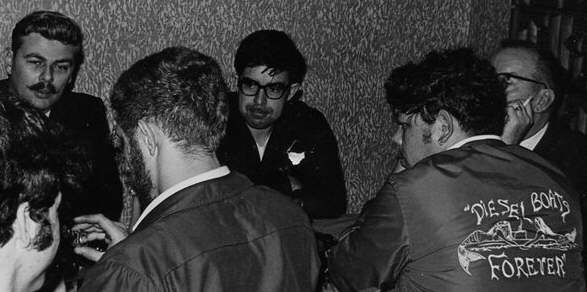
In July 1975 the last guppy submarine in US service, USS Tiru SS-416,
decommissioned in Charleston SC. A handful of the guppies sailed on in
foreign service into the late 90’s with two, ex-USS Cutlass SS-478, and
ex-USS Tusk SS-426 continuing to serve today in the Republic of China
(Taiwan) navy as training boats. The last diesel attack boats in US
service were USS Darter SS-576, USS Barbel SS-580, USS Blueback SS-581,
and USS Bonefish SS-582. They decommissioned between 1988 and 1990. Two
Tang class boats, ex-USS Tang SS-563, and ex-USS Gudgeon SS-567, recently
decommissioned in the Turkish Navy with ex-Gudgeon slated to be Turkey’s
museum submarine. The Turkish skipper of ex-Tang when asked about the
difference between the German designed and built replacement boats for
their retiring ex-US boats is reported to have said, “American submarines
are built for war, German submarines are built for export.” (6)
It’s ironic that 15 years after decommissioning of USS Blueback SS-581
at the Submarine Base in San Diego, a Swedish Navy Type A-19 Gotland Class
Air Independent Diesel Boat is conducting weekly ops there to
“familiarize” US Navy ASW forces with the operating characteristics of
advanced non-nuclear submarines. When the Swedish crew comes ashore on
Friday after a week at sea they still look and smell like the smokeboat
sailors of old. Our current crop of submariners avoids them.
The DBF pin, originally designed by a USS Barbel SS-580 crewmember as
an unofficial insignia to recognize the diesel boats ability to fill-in on
very short notice for broke-down nuke boats, now resides with pride on the
blue vests of Submarine Veterans who qualified and served on smokeboats.
Today the DBF pin is the unique symbol of the professionalism, discipline,
and camaraderie of American smokeboat sailors who sailed on, unloved,
unwashed, and underpaid as their era was coming to a close. DBF!
Notes:
- USS Dolphin AGSS-555 was completed and commissioned after the Barbel
class were operational. Dolphin, a deep submergence research submarine,
is diesel-electric. She continues her research projects out of San
Diego.
- USS Seawolf SSN-575 was in the yard at EB having her liquid sodium
reactor replaced with a pressurized water reactor similar to Nautilus.
Seawolf would not rejoin the fleet until late 1960.
- Wier, Gary E., FORGED IN WAR, The Naval-Industrial Complex and
American Submarine Construction 1940-1961, Brassey’s, Herndon, VA, 1998.
- The following is the gist of a conversation the author had with the
CO of HMAS Onslow S-60 in early 1972 during a cocktail party onboard the
boat while they were in port in Pearl Harbor.
“Following long
standing custom and tradition the RN viewed nuclear propulsion as just
another method of making steam and decided that with proper training
their engineering officers would have no problem operating the plants.
Following this line of thinking they also determined that submarine
commanders did not have to be qualified and experienced nuclear
engineers to ascend to command of a nuke boat.” The RN continues to
follow this operational philosophy to this day.
- ‘Dex’ Armstrong, The Take From A Trash Dumper, THE PUMP ROOM, The
Mare Island Base Newsletter, Volume VII, Issue 10, October 2005, USSVI.
- Reported to the author in January 2004 by a USS Pampanito SS-383
volunteer who had just returned from a trip to Turkey where he had
filmed submarine operations onboard ex-USS Tang SS-563.
The Author
Patrick Meagher, TMC(SS) USN RET. Qualified and served on USS Cusk
SS-348, USS Andrew Jackson SSBN-619B, and USS Barbel SS-580. He served on
active duty with the Submarine Force from 1960 through 1977. A life member
of USSVI, and associate member of USSVWWII, he wears a DBF patch on his
blue vest.
Photo Credit
With the exception of the top-most photo, all
photos are courtesy of Steve Mailho via Edward Hayden (his USS Barbel
photo collection). To view Edward's complete collection of USS
Barbel photos, visit this
site .
|
 |
 |
